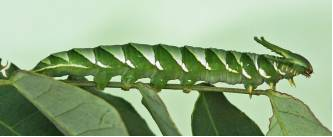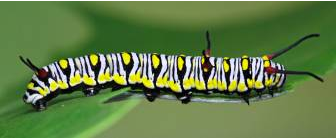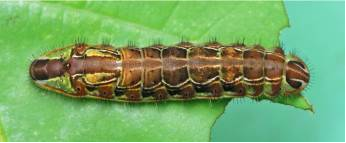The Fascinating World of Caterpillars
Most people admire the beauty and grace of butterflies when they notice them fluttering around in our parks and gardens. The amazing colours, shapes and diversity of our butterflies never cease to thrill nature lovers.
However, the same cannot be said for the caterpillars of these butterflies. We have seen people cringing in fear at caterpillars, as the physical appearance of these unattractive worm-like, and sometimes hairy, creatures is often quite difficult for the layman to appreciate
| Caterpillars of Singapore's Butterflies Learn more about the early stages of 80 more commonly-seen caterpillars in Singapore. The book is available at Singapore Botanic Gardens' retail shops: the Garden Shop and Library Shop, as well as major bookstores at $26 (inclusive of GST). Or take part in our contest to win a copy! |
Avid gardeners, for one, consider caterpillars pests that ought to be eliminated as quickly as possible, before they devour their precious plants. Children are also often taught by their parents to shun these ugly 'hairy worms' - literally translated from what they are called in Chinese (毛虫) or in Malay (Ulat bulu).
While there may be some truth in this, because many moth caterpillars may be harmful if touched, the majority of butterfly caterpillars are actually quite harmless. Our new book, the Caterpillars of Singapore's Butterflies, traces the early stages of 80 of our local butterfly species from the time the mother butterfly lays an egg on the host plant that the caterpillar will feed on.
It then follows the fascinating development of the caterpillar as it emerges from the egg, through several instars or growth stages until it becomes a pupa. At the same time, you'll discover what the different early stages look like and what types of plants they feed on.
You will marvel at the wide range of shapes, colours and sizes of butterfly eggs, caterpillars and pupae. Interesting facts are also shared in the book, such as defensive mechanisms. Some caterpillars take on the appearance of bird droppings, others create leaf shelters, while a few species consume leaves of poisonous plants and store the toxins in their body, thus making themselves distasteful to predators.
For people who are interested in setting up butterfly gardens, the book also shares tips on landscaping features that are necessary for creating a conducive environment for butterflies to survive. For instance, not many people may be aware that butterflies prefer humid conditions. Hence, it is important to include a water body in the garden. We hope that by sharing the information about the early stages of butterflies, more Singaporeans will gain knowledge about our rich biodiversity and do their part to conserve and cherish Singapore's natural heritage.
So, when you next see an 'ugly duckling' caterpillar in your garden or when you take a walk in the park, let them live; for they will soon transform into the beautiful and elegant butterflies that you enjoy and admire.
If you enjoy viewing butterflies, a good place to visit is the Butterfly Garden at HortPark. It is opened to the public from 9am to 12pm every last Saturday of the month.
By Khew Sin Khoon & Horace Tan
Photos by Horace Tan
Author Notes:
Khew Sin Khoon and Horace Tan are avid butterfly watchers who spend their free time in parks, gardens and the various nature areas photographing and observing butterflies in their natural environment. Horace, in particular, has an interest in the early stages of the life cycle of butterflies, documenting the detailed development of butterflies' life cycle from egg to pupa and adult.
Both Sin Khoon and Horace are also members of a group of butterfly enthusiasts and photographers called ButterflyCircle (www.butterflycircle.com).

The dragon-like caterpillar of the Plain Nawab creates a shelter using a web of silk threads spun on the surface of one or more leaves or leaflets of its host plant.

The caterpillar of the Plain Tiger advertises its toxicity to predators through its vivid colouring.

The Centaur Oakblue has nectary glands which weaver ants residing on the same plant will feed on. In turn, the ants help deter predators from preying on the caterpillar.
Have views or comments on this article? Let us know via this form. If you would like to give us feedback on any other areas relating to our parks and gardens, please submit via https://www.nparks.gov.sg/feedback



10/13/2021 11:52:25 AM